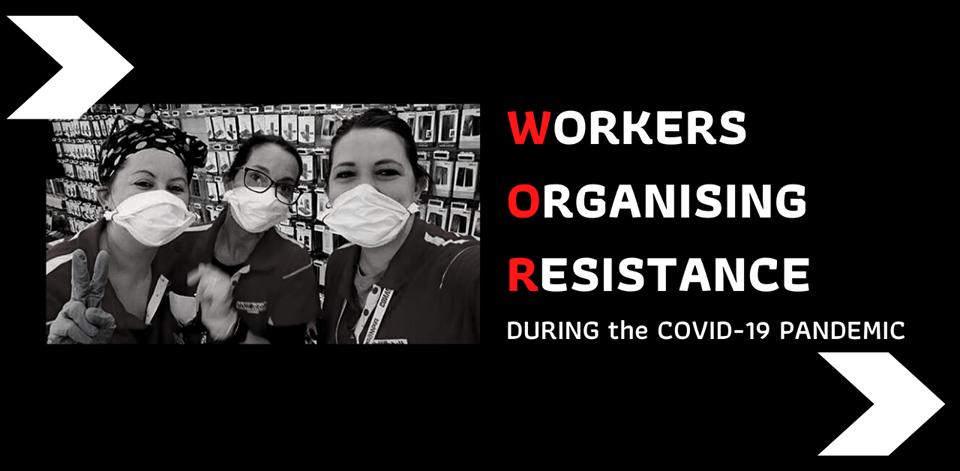We're workers organising resistance in the pandemic

I’ve lost count of how many times I’ve been told to wash my hands. But what if you work in a workplace with a break room that doesn’t have a sink? With no supplies of hand sanitiser are provided? And what if over 100,000 people come through your workplace every day and your job is to provide them with customer service?
That was the experience of one of the many workers who have shared their stories with Workers Organising Resistance during the Pandemic (WOR), a new Facebook page and discussion group set up to share stories of our conditions at work and our experiences of organising and fighting for safety and dignity.
The good news is that workers in Australia are not just accepting these conditions. The customer service worker with no hand sanitiser and no sink told WOR: “We organised for a group of workers to refuse to continue working until sanitiser was found, which it quickly was. We then sent a joint email to management and their health and safety reps raising concerns about the breakroom sink and nearby toilets that were not operational. After escalating their concerns with the union and senior management plumbers were organised and a sink was operational within 24 hours – a small victory!”
While the leadership of our unions wait for their invitations to official meetings with government and management, some workers are taking action into their own hands. Like the university workers in Melbourne, rostered onto a student help desk that normally sees dozens of students a day: they simply refused to staff it, because any form of social distancing would have been impossible. For them, waiting was not an option.
With government schools still open across the country, and mounting evidence to suggest that closing schools can help to delay and reduce the peak of an epidemic, teacher activists are organising and campaigning to the government to shut down schools. Importantly, any shut down must guarantee indefinite emergency leave pay and provide free childcare and small-scale classrooms for school-aged children of healthcare and hospital workers. (Sign their petition,)
If there aren’t many other union members at your workplace, organising is a big challenge but not impossible. When workplaces are rapidly closing, it can become even harder. Retail and hospitality workers who are employed casually face the prospect of being thrown out of work indefinitely. Despite the challenges, workers are getting together with their workmates and organising open letters to management, listing their demands, and demanding their rights under health and safety legislation.
A delegate working in a bakery reported how management had already conceded some of their demands after adding pressure with an open letter. They wrote: “One thing I've noticed is that health and safety measures are something that can really activate people. It's a good combination of looking out for your own safety but also practising social responsibility. It's a good way to get people placing demands on the boss for the necessary supplies to implement them. If you have a solid list of suggestions for procedures it could help to cohere people.” Others are sharing their workplace petitions and comparing demands.
A casual worker who gets sick, or who is exposed to COVID-19, might face a choice between going to work to spread the pandemic, or losing their pay – or their job. One call centre worker writes: “I’m a delegate and our workplace is currently refusing to pay us sick leave (as we are all casual) despite the fact that their parent company has promised all of its workers leave in response to COVID-19. We are having an on-shift union meeting tonight and will be distributing stickers to people wear on shift that say SRC: SERIOUSLY RISKING CORONAVIRUS. PAID LEAVE NOW”. Some big employers have now started to offer paid sick leave for casuals, but often with 14-day limits and only in the case of self-isolation.
“I’m working at a suburban retail store where the manager's housemate has tested positive for COVID-19 and the manager has been home sick with fever for 9 days,” one worker wrote. “We are operating under the assumption that he has COVID-19. The manager, 9 days ago, came in with a fever, used the store phones and point of sales systems until we made him leave. Upper-level management are refusing to close the store or tell anyone about the situation. Everyone who was rostered there today called in sick; management got staff from other stores and didn't tell them what the situation was. Of 9 regular staff, 4 have now showed COVID-19 symptoms in the past week”.
There are two huge issues so far: getting access to proper sanitary protection, and pay for casual leave. One worker who works for a big company providing essential services reported “at my workplace they keep saying they’re out of hand sanitiser... then we cause a big fuss and eventually a new bottle appears. We’ve been asking for a while how much they have and they keep trying not to tell us. Today someone managed to catch our manager getting sanitiser out of the safe and we saw there are 20 bottles”. A few hours later, it was reported that after workers continued to agitate a large delivery of hand sanitiser and disinfectant wipes were delivered to the same company’s multiple workplaces.
While the government tries to tell us we’re all in this together we know that it is the workers who will be forced to pay unless we organise collective resistance. We hope that WOR will be able to organise simultaneous actions over common demands. Governments and employers will continue to attack our rights, we want WOR to work with our unions to be able to organise coordinated responses. When they try to make us pay for their crisis, we must resist.
If you're a workplace activist, get involved with WOR by following the Facebook page and joining the discussion forum.